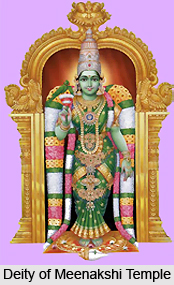 History of Meenakshi Temple, Tamil Nadu, can be traced back to the Indian mythology. It is believed that the temple was founded by the king of celestial deities, Indra, during the time of his pilgrimage which he undertook to atone for his misdeeds. As he reached near the swayambu lingam of Madurai, which is referred to the self formed lingam and is a representation of Lord Shiva, he felt his burden lifting. According to him, the miracle occurred due to the lingam and thus he built the temple to enshrine it. Indra worshipped Lord Shiva in the temple and the latter created the golden lotus in the pool situated nearby.
History of Meenakshi Temple, Tamil Nadu, can be traced back to the Indian mythology. It is believed that the temple was founded by the king of celestial deities, Indra, during the time of his pilgrimage which he undertook to atone for his misdeeds. As he reached near the swayambu lingam of Madurai, which is referred to the self formed lingam and is a representation of Lord Shiva, he felt his burden lifting. According to him, the miracle occurred due to the lingam and thus he built the temple to enshrine it. Indra worshipped Lord Shiva in the temple and the latter created the golden lotus in the pool situated nearby.
Over the last two millennia, the temple finds its mention in the Tamil literature. As per a famed Hindu saint of Saiva philosophy, Thirugnanasambandar, the temple belongs to 7th century and he has also described its deity as Aalavai Iraivan. It is believed that in 1310, the temple was demolished by the infamous Muslim invader Malik Kafur and all the ancient elements of the temple got destroyed along with it.
The first Nayak king of Madurai, Viswanatha Nayak (1559 -1600), took the initiative to reconstruct the temple. The renovation of the structure was supervised by the prime minister of the Nayak dynasty and the founder of the Poligar System, Ariyanatha Mudaliar. The original design of Meenakshi Temple was created in 1560 by Vishwanatha Nayak which was later considerably expanded to its present structure during the regime of Thirumalai Nayak (1623-55). Several complicated structures were erected inside the temple as the ruler took much interest in developing the temple. Some of the major contributions by the ruler include the construction of Kilikoondu Mandapam (corridor of parrots) and the Vasantha Mandapam for celebrating vasanthorsavam (spring festival). The Meenatchi Nayakar Mandapam and the corridors of the temple tank were constructed by Rani Mangammal.
In the year 1812, the Collector of Madurai was Rous Peter who was nicknamed as Peter Pandian for his respect towards all faiths and equal treatment to the people belonging to all religions. He also contributed to the temple by donating a set of golden stirrups studded with diamonds and red stones. It is believed that Goddess Meenatchi once saved Rous Peter from a fatal incident. He had also wished that after his death, his body must be buried in such a position that his eyes would face the temple.





















